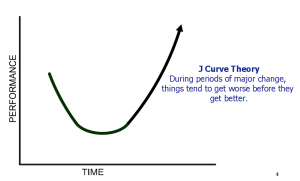The Learner and the “J” Curve
Leaders are not needed to maintain the status quo; managers are capable of providing that service. Leaders are needed to take an organization to a new, desired place.
A leader must be a Learner, that is, a person who is willing to challenge the assumptions, opinions, and facts that have defined his (her) life and career to date. The Learner has a flexible world view, one where he (she) is able to allow new and different perspectives on situations and opportunities to develop. The J Curve Theory is a valuable tool for Learners and Leaders.
The J Curve Theory was developed over 150 years ago to describe the economic behavior of nations. In its essence, the J Curve is a very positive theory. “During periods of major change, things tend to get worse before they get better.” The optimistic perspective comes from the phrase, “things will get better”. Is it true? Will things get better? Is being in a bad place a prerequisite for being in a good place later? The answer is, unfortunately, no. Simply being in a bad place provides absolutely no assurance that better days are ahead. What the J Curve is saying, however, is that if you are in a bad place and you are doing all that needs to be done to change the situation, then you will experience declining performance before you achieve improved performance; “things will get worse before they get better”.
The key then becomes one of knowing all that needs to be done to change the situation. Einstein has two quotes which are relevant to J Curve thinking. The first is, “You cannot solve a problem from the same consciousness that created it. You must learn to see the world anew.” The second is Einstein’s definition of insanity as, “doing the same thing over and over again, expecting different results”.

The J Curve has been used to describe the process of change in medical conditions, economic performance of nations, the learning performance of students along with many other applications such as the performance of organizations. In the context of the performance of organizations, the application of the J Curve has five required factors:
- There must be a stable or growing market for the product/service.
- The underlying concepts must be different than those in place at
the beginning of the period of decline. - People inside the system must believe in the better way.
- There must be a sense of urgency in accomplishing the needed
- There must be accepted means of measuring results.
The first point is critical. Is the organization relevant within its universe? Does the organization provide value or have real potential to provide value to its stakeholders? Is the desire to receive value at least stable and preferably growing? If the answer to this hurdle question is no, there will be no J Curve effect. The decline being experienced will continue until terminal failure occurs.
The second factor goes expressly to the issues stated in the Einstein quotes. If an organization thinks the same way, has the same world view, uses the same tools as it did when the period of decline started, then it will, despite all of its best intentions, fail to change the declining trend.
For an organization to create change, people within the organization must want it to change. The mass of change agents can initially be very small, but they have to exist and they have to create a voice. If there is a need for the product or service provided (Factor 1) and there are no change agents within the organization or the change agents have lost their voice, then an alternative organization will be created and will succeed where the legacy organization failed. It must be understood that no organization earns the right to have a future based on it past accomplishments. An organization earns its future with its present creation of value.
There is an old business axiom which states that the best catalyst for change is crisis. A crisis is a period where the need for urgent action is recognized. Slow, gradual change tends to fail to create the sense of urgency needed to foster major change. Creating the needed urgency within an organization for change is an early and vital function of the change leader.
The last factor comes out of another old business axiom: If you can’t measure it, you can’t manage it. In the case of changing organizational performance, gut feel, the intuitive sense that things are getting better, is not good enough. Metrics must exist to measure performance of the new model of operation. Although there must be some overlap with the metrics of the old operational model, the driving force behind creating meaningful change comes from the design of metrics, which reflect the new model and measure what you want to become.
If the five preceding factors are in place, the J Curve tells us that we will first find the bottom in performance and then begin a period of improvement. Knowing that things will improve, however, is not the same as having things improve. The biggest part of the job remains ahead.
Learning Leads to Achieving,
Joe Schumacker
September 2010


 Posted in
Posted in